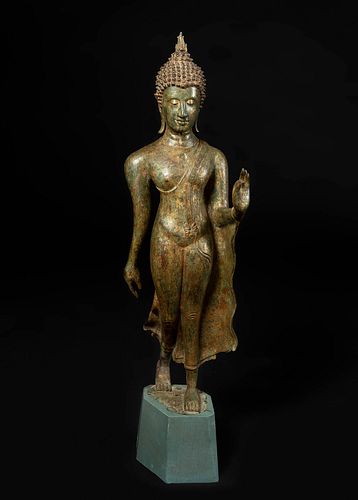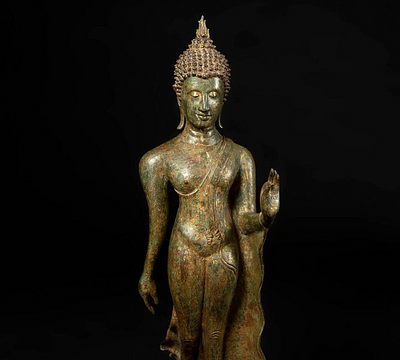Walking Buddha figure; Thailand, Sukhothai Period, XIV-XV centuries. Bronze with traces of polychrome on wooden base.
Lot 49
About Seller
Setdart Auction House
Carrer Aragó 346
Barcelona
Spain
Setdart Subastas was born in 2004 and is currently the first online art auction in Spain with solidity, prestige and reliability guaranteed by our more than 60,000 users. Setdart has a young, dynamic and enterprising team ready to successfully manage the purchase and sale of art works through custom...Read more
Estimate:
EUR€8,000 - EUR€10,000
$8,602.15 - $10,752.69
Absentee vs Live bid
Two ways to bid:
- Leave a max absentee bid and the platform will bid on your behalf up to your maximum bid during the live auction.
- Bid live during the auction and your bids will be submitted real-time to the auctioneer.
Bid Increments
| Price | Bid Increment |
|---|---|
| EUR€0 | EUR€10 |
| EUR€200 | EUR€25 |
| EUR€500 | EUR€50 |
| EUR€1,000 | EUR€100 |
| EUR€3,000 | EUR€200 |
| EUR€5,000 | EUR€500 |
| EUR€10,000 | EUR€1,000 |
| EUR€20,000 | EUR€2,000 |
| EUR€50,000 | EUR€5,000 |
About Auction
By Setdart Auction House
Nov 22, 2021
Set Reminder
2021-11-22 10:00:00
2021-11-22 10:00:00
America/New_York
Bidsquare
Bidsquare : 22nd November - Oriental Art
https://www.bidsquare.com/auctions/setdart-auction-house/22nd-november---oriental-art-7877
Setdart Auction House sofia@setdart.com
Setdart Auction House sofia@setdart.com
- Lot Description
Walking Buddha figure; Thailand, Sukhothai Period, XIV-XV centuries. Bronze with traces of polychrome on wooden base. Measurements: 63 x 22 x 25 cm; 12 cm (base height). Bronze round sculpture of great quality, with remains of the original polychrome, from Thailand, specifically from the region of Sukhothai, and dated between the XIV-XV centuries. It is a Sukhothai Walking Buddha, a typology of Buddha characteristic of Thai art of the 13th century, corresponding to the Sukhothai period, considered the golden age of Thai civilization, which dramatically influenced all other subsequent periods. The piece in question can be compared with the one in the British Museum (registration number: 1947,0514.1). The depiction has its roots in the life of the Buddha himself: after renouncing his early life as a prince, the Buddha spent the rest of his years as a mendicant, teaching throughout northern India. Thai images (unlike what happened in other territories that focused on the conception of the Buddha as a divine being) presented a new image of the Buddha walking among the people, emphasizing his earthly aspects. As for his morphology, it is worth mentioning how the Sukhothai style of sculpture is very distinctive, with long, smooth limbs, great corpulence, an oval face and a soft modeling of clothing. The Sri Lankan influence is clear in the flame-shaped ushnisha seen on the Buddha's head. Thus, we are faced with the figure of the Buddha walking, in an upright position and making a gesture of consolation (abhayamudra) with his right hand. A gauze hangs from his left arm and his sinuous body is covered with fine cloth, represented with subtle chisels, distinguishing the ceremonial cincture. The bun hairstyle is a symbol of meditation, concentrated spiritual life and wisdom. Above the headdress, a flame symbolizes the light of illumination. The eyelids are a symbol of spiritual concentration and purity, because of their similarity to the petals of the lotus, and complete a serene face with a sketched smile, symbol of the balance and serenity of a perfect being. The elongated earlobes allude to the large earrings worn by members of the upper classes in India contemporary to Sakyamuni, and represent the concepts of greatness, nobility and wisdom. Other "lakshana" present here are the folds in the neck symbolizing happiness and the cincture across his chest, which alludes to the Buddha's connection with the Buddhist community.
- Shipping Info
-
In-house shipping available. Please inquire at admin@setdart.com.
-
- Buyer's Premium



 EUR
EUR CAD
CAD AUD
AUD GBP
GBP MXN
MXN HKD
HKD CNY
CNY MYR
MYR SEK
SEK SGD
SGD CHF
CHF THB
THB








